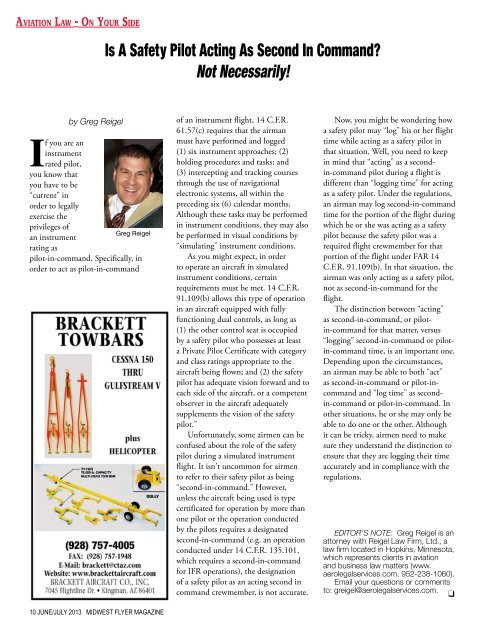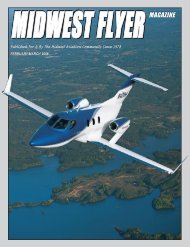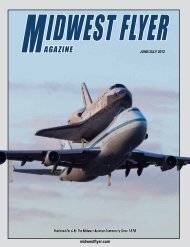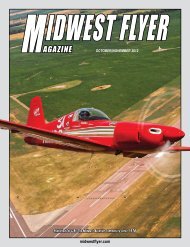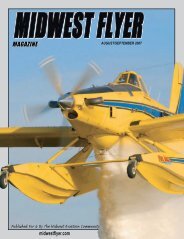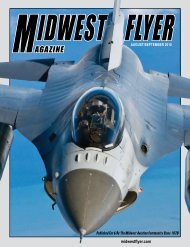You also want an ePaper? Increase the reach of your titles
YUMPU automatically turns print PDFs into web optimized ePapers that Google loves.
Aviation Law - On Your Side<br />
Is A Safety Pilot Acting As Second In Command<br />
Not Necessarily!<br />
by Greg Reigel<br />
If you are an<br />
instrument<br />
rated pilot,<br />
you know that<br />
you have to be<br />
“current” in<br />
order to legally<br />
exercise the<br />
privileges of<br />
an instrument<br />
rating as<br />
pilot-in-command. Specifically, in<br />
order to act as pilot-in-command<br />
Greg Reigel<br />
10 JUNE/JULY 2013 MIDWEST FLYER MAGAZINE<br />
of an instrument flight, 14 C.F.R.<br />
61.57(c) requires that the airman<br />
must have performed and logged<br />
(1) six instrument approaches; (2)<br />
holding procedures and tasks; and<br />
(3) intercepting and tracking courses<br />
through the use of navigational<br />
electronic systems, all within the<br />
preceding six (6) calendar months.<br />
Although these tasks may be performed<br />
in instrument conditions, they may also<br />
be performed in visual conditions by<br />
“simulating” instrument conditions.<br />
As you might expect, in order<br />
to operate an aircraft in simulated<br />
instrument conditions, certain<br />
requirements must be met. 14 C.F.R.<br />
91.109(b) allows this type of operation<br />
in an aircraft equipped with fully<br />
functioning dual controls, as long as<br />
(1) the other control seat is occupied<br />
by a safety pilot who possesses at least<br />
a Private Pilot Certificate with category<br />
and class ratings appropriate to the<br />
aircraft being flown; and (2) the safety<br />
pilot has adequate vision forward and to<br />
each side of the aircraft, or a competent<br />
observer in the aircraft adequately<br />
supplements the vision of the safety<br />
pilot.”<br />
Unfortunately, some airmen can be<br />
confused about the role of the safety<br />
pilot during a simulated instrument<br />
flight. It isn't uncommon for airmen<br />
to refer to their safety pilot as being<br />
“second-in-command.” However,<br />
unless the aircraft being used is type<br />
certificated for operation by more than<br />
one pilot or the operation conducted<br />
by the pilots requires a designated<br />
second-in-command (e.g. an operation<br />
conducted under 14 C.F.R. 135.101,<br />
which requires a second-in-command<br />
for IFR operations), the designation<br />
of a safety pilot as an acting second in<br />
command crewmember, is not accurate.<br />
Now, you might be wondering how<br />
a safety pilot may “log” his or her flight<br />
time while acting as a safety pilot in<br />
that situation. Well, you need to keep<br />
in mind that “acting” as a secondin-command<br />
pilot during a flight is<br />
different than “logging time” for acting<br />
as a safety pilot. Under the regulations,<br />
an airman may log second-in-command<br />
time for the portion of the flight during<br />
which he or she was acting as a safety<br />
pilot because the safety pilot was a<br />
required flight crewmember for that<br />
portion of the flight under FAR 14<br />
C.F.R. 91.109(b). In that situation, the<br />
airman was only acting as a safety pilot,<br />
not as second-in-command for the<br />
flight.<br />
The distinction between “acting”<br />
as second-in-command, or pilotin-command<br />
for that matter, versus<br />
“logging” second-in-command or pilotin-command<br />
time, is an important one.<br />
Depending upon the circumstances,<br />
an airman may be able to both “act”<br />
as second-in-command or pilot-incommand<br />
and “log time” as secondin-command<br />
or pilot-in-command. In<br />
other situations, he or she may only be<br />
able to do one or the other. Although<br />
it can be tricky, airmen need to make<br />
sure they understand the distinction to<br />
ensure that they are logging their time<br />
accurately and in compliance with the<br />
regulations.<br />
EDITORʼS NOTE: Greg Reigel is an<br />
attorney with Reigel Law Firm, Ltd., a<br />
law firm located in Hopkins, Minnesota,<br />
which represents clients in aviation<br />
and business law matters (www.<br />
aerolegalservices.com, 952-238-1060).<br />
Email your questions or comments<br />
to: greigel@aerolegalservices.com.<br />
q


